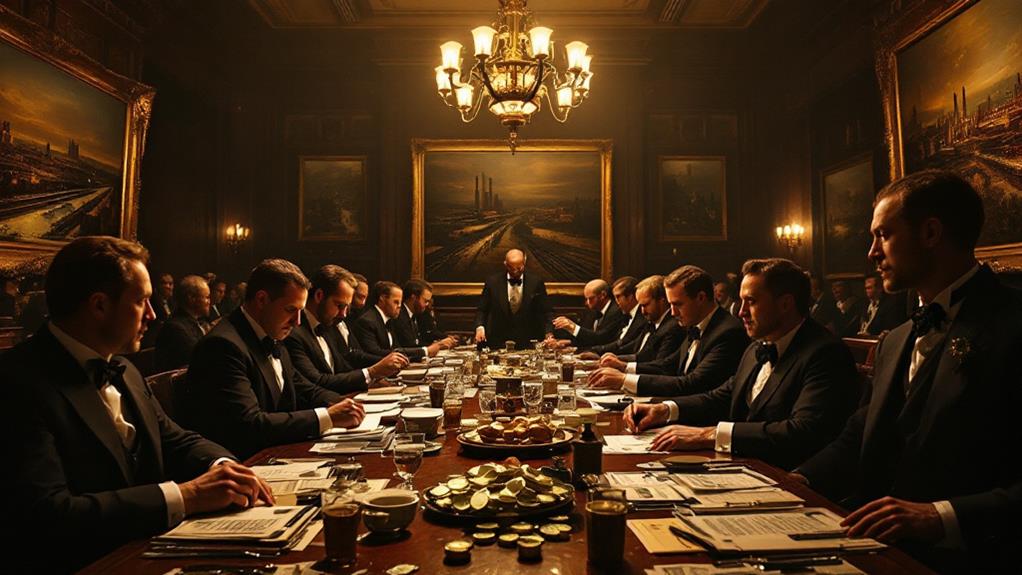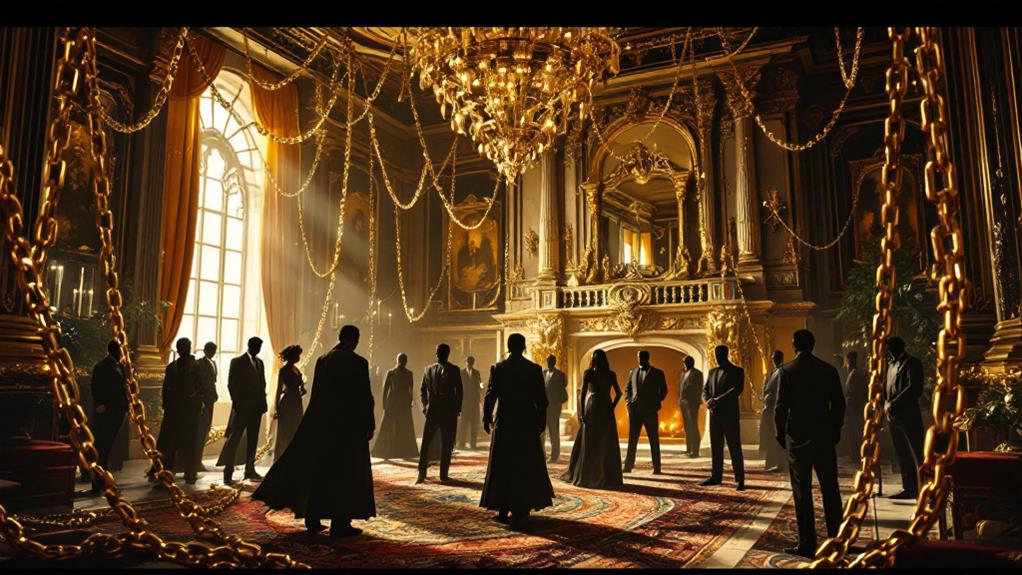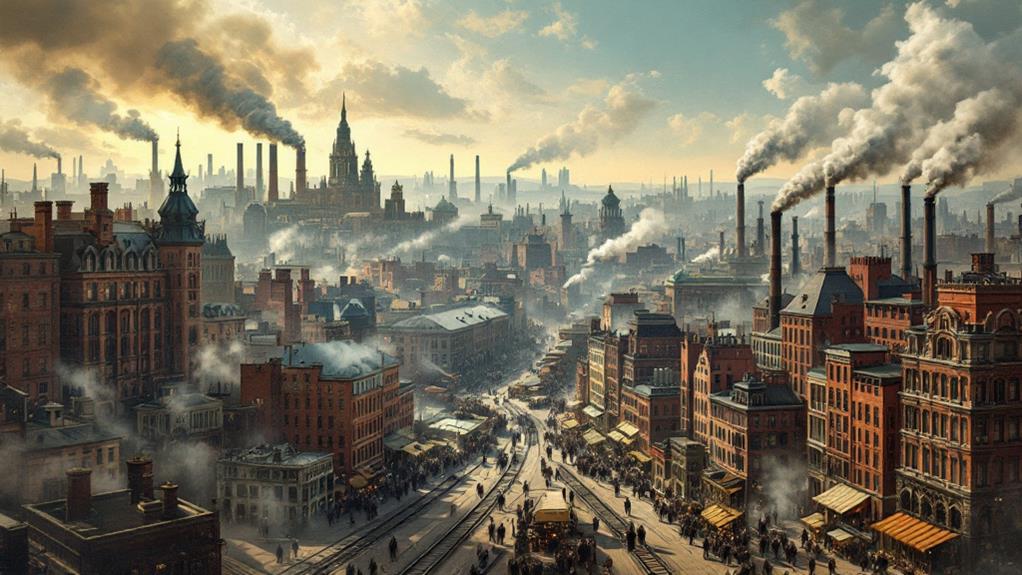Who Were the Infamous Robber Barons and What Did They Do?

You might wonder who the infamous robber barons were and what impact they left. Figures like Andrew Carnegie, John D. Rockefeller, and Cornelius Vanderbilt built massive fortunes in the late 19th century, transforming industries and the American economy. They used tactics like vertical integration and monopolies to dominate markets, often at the expense of fair competition and workers' rights. While criticized for exploitation, they also contributed greatly to philanthropy, funding libraries and educational institutions. Their actions sparked labor movements and led to antitrust laws. If you're curious about their enduring legacy and influence, there's more to uncover.
Key Figures in Industry
In the world of industry titans, few names resonate as powerfully as those of Andrew Carnegie, John D. Rockefeller, Cornelius Vanderbilt, J.P. Morgan, and Jay Gould. These men, often labeled as "robber barons," wielded immense wealth and power, reshaping America's economic landscape. Andrew Carnegie, a key figure in the steel industry, capitalized on his business practices to build Carnegie Steel, which he later sold to J.P. Morgan for an astounding $492 million. This deal solidified Morgan's influence, allowing him to create U.S. Steel, the initial billion-dollar corporation.
John D. Rockefeller dominated the oil industry with Standard Oil, controlling 90% of U.S. refineries by the 1880s. His fortune, adjusted for inflation, makes him possibly the wealthiest American ever. Meanwhile, Cornelius Vanderbilt transformed transportation with his shipping and railroads, especially the New York Central Railroad, which altered travel across the U.S.
Jay Gould, known for his controversial business practices, amassed wealth through railroad investments and stock manipulation, including a notorious attempt to corner the gold market in 1869. Together, these figures epitomize the period's blend of innovation and ruthless ambition.
Business Strategies and Tactics
Steel beams rose alongside the ambitions of the robber barons, as they crafted business strategies that reshaped industries. You'd find that vertical integration was key to their success. Take Andrew Carnegie for instance; he dominated the steel industry by controlling every aspect of production from raw materials to distribution. This method guaranteed efficiency and cost-effectiveness, leaving competitors struggling to keep up.
Robber barons didn't stop there. Predatory pricing became another favorite tactic. John D. Rockefeller used it effectively in the oil industry, slashing prices to drive rivals out of business, then hiking them once he gained control. By forming trusts and monopolies, they further eliminated competition. J.P. Morgan exemplified this by consolidating companies into U.S. Steel, the initial billion-dollar corporation.
Yet, these strategies often veered into unethical practices. Figures like Jay Gould manipulated stocks and bribed politicians, as seen in the Erie Railroad conflict. Labor exploitation was rampant too. Robber barons like Carnegie opposed unions, maintaining low wages and harsh conditions, evident during the Homestead Strike. Ultimately, their relentless pursuit of dominance often came at the expense of fair competition and workers' rights.
Wealth and Influence

Imagine wielding a fortune so vast it could rival entire nations. As a robber baron during the Gilded Period, you'd harness immense wealth and influence, reshaping entire industries. Andrew Carnegie, for instance, transformed the steel industry. By selling Carnegie Steel to J.P. Morgan for $492 million in 1901, he became the richest man globally, dramatically impacting the U.S. economy. Likewise, John D. Rockefeller's control over 90% of U.S. oil refineries in the early 1880s made him one of history's wealthiest figures, with a present-day net worth exceeding $400 billion.
These titans of industry didn't just amass wealth; they wielded influence that shaped the nation's economic landscape. Cornelius Vanderbilt, through his shipping and railroad empires, changed transportation and amassed a fortune of around $105 billion today. J.P. Morgan's creation of U.S. Steel Corporation, the initial billion-dollar company, further exemplified the power and economic disparities of the period. The combined fortunes of these robber barons dwarfed entire nations, spotlighting the stark economic disparities of the Gilded Period. Their legacies linger in the lasting impact they had on industry and the vast economic divides they highlighted.
Philanthropy and Public Perception
How did the notorious robber barons manage to reshape their tainted reputations? They turned to philanthropy, using their immense wealth to alter public perception. Andrew Carnegie, once criticized as a robber baron, advocated for wealth redistribution through his essay "The Gospel of Wealth." He donated over $350 million to numerous causes, including:
- Public Libraries: Carnegie funded over 2,500 libraries, increasing public access to knowledge.
- Educational Institutions: His contributions helped establish numerous schools and universities.
- Cultural Venues: Carnegie's donations supported the creation of concert halls and museums.
- Lasting Legacies: These efforts shifted views, portraying him as a benefactor rather than a ruthless capitalist.
Similarly, John D. Rockefeller, initially vilified for his monopolistic practices, dedicated over $500 million to philanthropy. He founded the Rockefeller Foundation, which supported education, health, and scientific research. This transformation from a monopolist to a philanthropic icon was strategic. These actions not only improved public perception but also left lasting legacies that continue to benefit society.
Despite these contributions, debates ensued about their motivations. Some viewed these philanthropic efforts as attempts to soften criticism of their earlier business tactics. However, their impact on educational institutions and cultural venues cannot be denied.
Economic and Social Impact

The economic and social impact of the robber barons was profound and multifaceted. By driving industrialization, figures like Andrew Carnegie and John D. Rockefeller transformed the United States into a global economic powerhouse. They established monopolies in steel and oil, enabling them to control prices and stifle competition. This aggressive wealth accumulation led to significant economic disparities, concentrating much of the nation's wealth in the hands of the top 1% and sparking public outcry.
These robber barons' business practices had serious social repercussions. Workers faced exploitation through low wages and poor conditions, which fueled labor movements and strikes, such as the infamous Homestead Strike in 1892. These movements highlighted the urgent need for workers' rights and social reform.
Despite their ruthless tactics, some robber barons engaged in philanthropy to improve their public image. Carnegie, for example, funded libraries and educational institutions, aiming to give back to society. Meanwhile, their concentration of power prompted political action, leading to the introduction of antitrust laws like the Sherman Antitrust Act of 1890. These laws sought to dismantle monopolistic practices and promote fair competition, reshaping the economic landscape and curbing the unchecked power of these industrial titans.
Legacy and Modern Reflections
While the robber barons' impact on society was marked by economic disparity and labor exploitation, their legacy continues to stir debate and reflection in current times. You can see how these captains of industry shaped American industrialization through wealth accumulation and monopolistic practices. Their influence persists now, especially as we grapple with wealth inequality and corporate power.
- Philanthropy: Andrew Carnegie and John D. Rockefeller's extensive charitable efforts are a significant part of their legacy. Carnegie's "The Gospel of Wealth" advocated for using wealth to benefit society, funding libraries and educational institutions.
- Economic Disparities: Criticism of the robber barons often centers on their exploitative labor practices and monopolistic strategies, which widened economic disparities. This led to the creation of antitrust laws, aiming to curb such behaviors and promote fair competition.
- Modern Parallels: The term "robber baron" has evolved, often used to describe contemporary billionaires like Jeff Bezos and Elon Musk, as society questions their roles in current wealth inequality.
- Infrastructure and Social Welfare: Despite their faults, the robber barons' investments in infrastructure and public institutions laid the foundation for the social welfare system, inspiring future generations to engage in philanthropy to tackle social issues.




